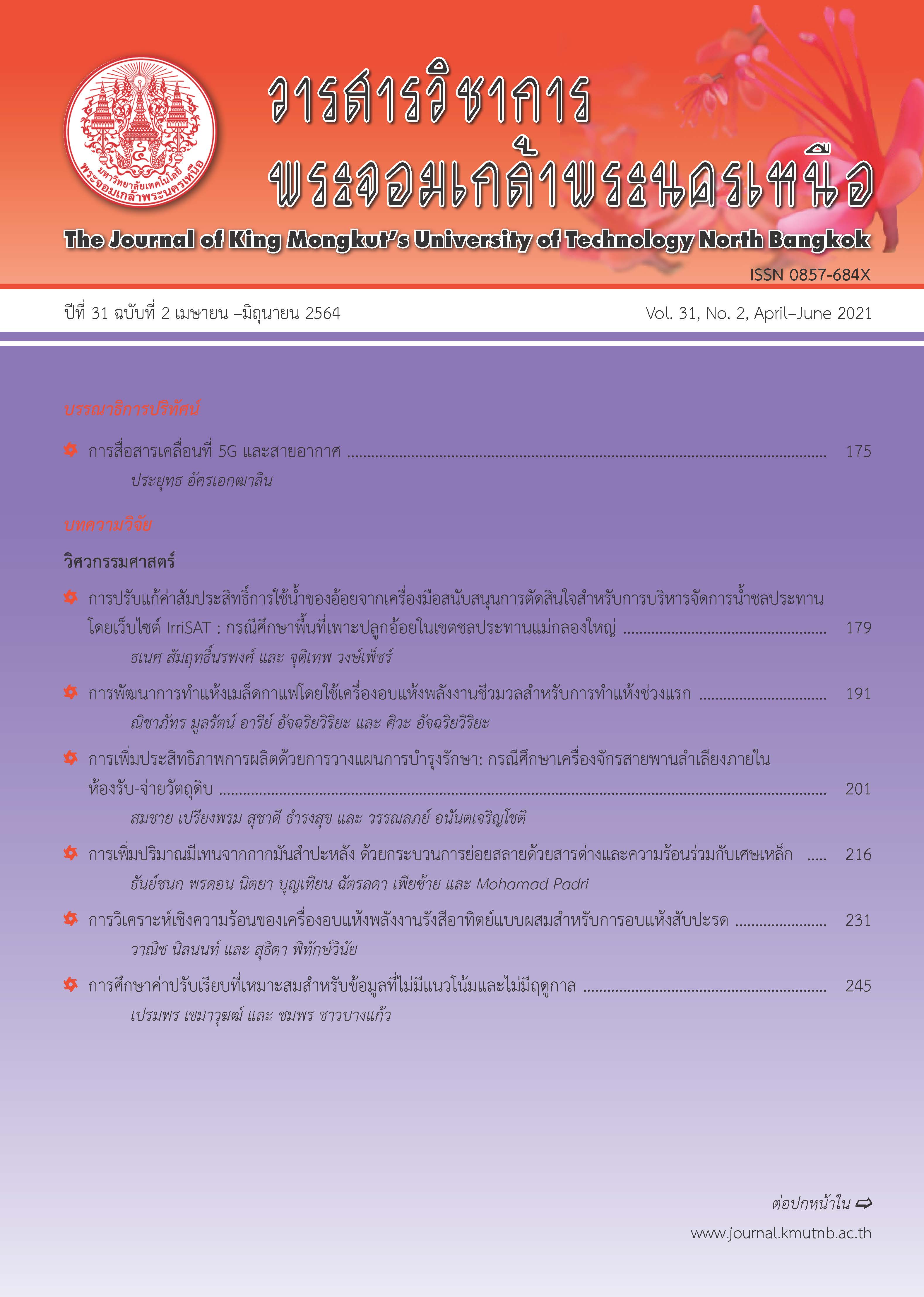การทดแทนโซเดียมไนไตรท์ในไส้กรอกด้วยผงสีจากการหมัก Monascus purpureus ร่วมกับวุ้นมะพร้าว
Main Article Content
บทคัดย่อ
งานวิจัยนี้เป็นการศึกษาการผลิตผงสีจาก Monascus purpureus 3 สายพันธุ์ ร่วมกับวุ้นมะพร้าว และศึกษาผลการใช้ผงสีดังกล่าวทดแทนโซเดียมไนไตรท์ในไส้กรอกทั้งคุณลักษณะทางเคมี จุลินทรีย์ และการประเมินทางประสาทสัมผัส ในการทดลองจะผลิตวุ้นมะพร้าวด้วย Acetobacter xylinum ได้แผ่นเซลลูโลสที่มีลักษณะเป็นแผ่นวุ้นสีขาวและหนา 2.5 เซนติเมตร จากนั้นนำมาผลิตผงสีโดยนำวุ้นมะพร้าวหมักร่วมกับ M. purpureus TISTR 3002, 3090 และ 3629 ในอาหารเหลวสังเคราะห์พบว่า ลักษณะปรากฏของวุ้นมะพร้าวหมักร่วมกับ M. purpureus TISTR 3090 มีสีแดงเข้มทั่วทั้งชิ้นวุ้นและมีค่า a* เท่ากับ 33.61 ซึ่งมากกว่าวุ้นมะพร้าวที่หมักร่วมกับ M. purpureus TISTR 3002 และ 3629 อย่างมีนัยสำคัญทางสถิติ จากนั้นนำวุ้นมะพร้าวที่หมักร่วมกับ M. purpureus ไปปั่นและอบแห้งที่อุณหภูมิ 70 องศาเซลเซียส พบว่า เวลาที่ 182 นาที เป็นระยะเวลาอบแห้งที่เหมาะสม ซึ่งทำให้ผลิตภัณฑ์มีความชื้นไม่เกินร้อยละ 5 นำผงสีที่ได้ศึกษาปริมาณการทดแทนโซเดียมไนไตรท์ในผลิตภัณฑ์ไส้กรอก โดยศึกษา 3 ระดับ คือ 0.25, 0.50 และ 0.75 ของน้ำหนักเนื้อ พบว่า ไส้กรอกสูตรเติมผงสีร้อยละ 0.50 เป็นสูตรที่เหมาะสมที่สุดซึ่งผู้ทดสอบให้การยอมรับในด้านสี ความนุ่ม ความแน่นเนื้อ และความชอบรวม ด้านองค์ประกอบทางเคมีของไส้กรอกสูตรเติมผงสีร้อยละ 0.50 พบว่า มีความชื้นร้อยละ 63.04 โปรตีนร้อยละ 17.96 ไขมันร้อยละ 13.64 เถ้าร้อยละ 1.99 คาร์โบไฮเดรตร้อยละ 1.67 และเส้นใยร้อยละ 1.70 ด้านคุณภาพทางจุลินทรีย์ พบว่าจำนวนจุลินทรีย์ทั้งหมดของไส้กรอกสูตรเติมผงสีร้อยละ 0.50 เท่ากับ 1.5×103 โคโลนีต่อกรัม และปริมาณยีสต์และราเท่ากับ 70 โคโลนีต่อกรัม
Article Details
บทความที่ลงตีพิมพ์เป็นข้อคิดเห็นของผู้เขียนเท่านั้น
ผู้เขียนจะต้องเป็นผู้รับผิดชอบต่อผลทางกฎหมายใดๆ ที่อาจเกิดขึ้นจากบทความนั้น
เอกสารอ้างอิง
[2] K. Sukatchasakun, “Watercress: The queen of vegetable,” in Thaihealthbook. Bangkok: Moh- Chao-Ban Publishing House, pp. 14–19, 2017 (in Thai).
[3] S. Eadmusik, “Utilization of agricultural residues from Monascus fermentation,” KKU Research Journal, vol. 19, no. 1, pp. 92–106, 2014 (in Thai).
[4] K. Rojsuntornkitti, N. Jittrepotch, T. Kongbangkerd, and K. Kraboun, “Substitution of nitrite by Chinese red broken rice powder in Thai traditional fermented pork sausage (Nham),” International Food Research Journal, vol. 17, no. 1, pp. 153–161, 2010.
[5] B. Yongsmith, Fermentative Microbiology of Vitamins and Pigments. Bangkok: Kasetsart University press, 1999 (in Thai).
[6] C. Tang-amornsuksan and W. Khrusong, “Nata de coco product mixed in lychee juice,” Food (Thailand), vol. 23, no. 2, pp. 107–114, 1993.
[7] C. Promwongpo, W. Yokhanit, and J. Khemacheewakul, “A study of the optimal fermentation conditions for Nata de coco production by Acetobacter xylinum TISTR 975 from mango Juice,” KMUTT Research & Development Journal, vol. 40, no. 2, pp. 271–282, 2017 (in Thai).
[8] P. Junsangsre, P. Srikamsukh, and W. Pankhaw, “Substitution of coconut juice by pineapple juice in Nata de coco - pina production,” Journal of Agriculture, vol. 18, no. 1, pp. 46–55, 2002.
[9] F. Sheu, C. L. Wang, and Y. T. Shyu, “Fermentation of Monascus purpureus on Bacterial Cellulose-nata and the Color Stability of Monascus-nata Complex,” Journal of Food Science, vol. 65, no. 2, pp. 342–345, 2000.
[10] S. Inkioe, “Use of Monascus pigment (Angkak) as an alternative to nitrite in smoked sausage and Chinese sausage,” M.S. thesis, Graduate School, King Mongkuts Institute of Technology Ladkrabang, Bangkok, Thailand, 2001 (in Thai).
[11] T. F. Lin and A. L. Demain, “Effect of nutrition of Monascus sp. on formation of red pigments,” Applied Microbiology and Biotechnology, vol. 36, pp. 70–75, 1991.
[12] P. Jermjumroon, R. Chumnongsart, and W. Sanoppa, “Studies on product from Manascus purpureus TISTR 3090 – Nata complex as an alternative in Chinese sausage,” Bachelor Degree, Department of Biology, Faculty of Science, King Mongkut’s Institute Technology of Ladkrabang, 2004 (in Thai).
[13] H. Al-Kahtani and B. H. Hassan, “Spray drying of roselle (Hibiscus sabciariffa L.) extract,” Journal of Food Science, vol. 55, no. 4, pp. 1073–1076, 1990.
[14] Official method of analysis, AOAC USA. Methods 925.10, 65.17, 974.24, 992.16, 2000.
[15] R. Srivibool, “The selection of Monascus purpureus strains suitable for pigment production,” M.S. thesis, Department of Biology, Faculty of Science, Chiangmai University, 1988 (in Thai).
[16] A. Hanpongkittikun, M. Haewsungcharem, and R. Pinthong, “Semi-industrial scale production of red pigment by Monascus purpureus from rice I. factors affecting red rice production,” M.S. thesis, Faculty of Agro-Industry, Chiangmai University, 1988 (in Thai).
[17] H. Ishiwata, M. Watanabe, and A. Tanimura, “Studies on the Hygienic Chemistry of Monascus pigments (I),” Journal of Food Safety and Hygiene, vol. 15, no. 1, pp. 36–37, 1974.
[18] O. R. Fennema, Food Chemistry, 3rd ed. CRC Press, 1996.

